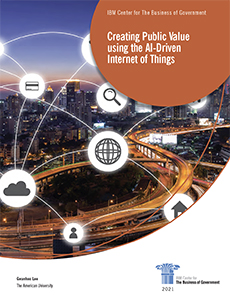
Creating Public Value using the AI-Driven Internet of Things

Government agencies seek to deliver quality services in increasingly dynamic and complex environments. However, outdated infrastructures—and a shortage of systems that collect and use massive real-time data—make it challenging for the agencies to fulfill their missions. Governments have a tremendous opportunity to transform public services using the “Internet of Things” (IoT) to provide situationspecific and real-time data, which can improve decision-making and optimize operational effectiveness.
In this report, Professor Lee describes IoT as a network of physical “things” equipped with sensors and devices that enable data transmission and operational control with no or little human intervention. Organizations have recently begun to embrace artificial intelligence (AI) and machine learning (ML) technologies to drive even greater value from IoT applications. AI/ML enhances the data analytics capabilities of IoT by enabling accurate predictions and optimal decisions in new ways. Professor Lee calls this AI/ML-powered IoT the “AI-Driven Internet of Things” (AIoT for short hereafter). AIoT is a natural evolution of IoT as computing, networking, and AI/ML technologies are increasingly converging, enabling organizations to develop as “cognitive enterprises” that capitalize on the synergy across these emerging technologies.
Strategic application of IoT in government is in an early phase. Few U.S. federal agencies have explicitly incorporated IoT in their strategic plan, or connected the potential of AI to their evolving IoT activities. The diversity and scale of public services combined with various needs and demands from citizens provide an opportunity to deliver value from implementing AI-driven IoT applications.
Still, IoT is already making the delivery of some public services smarter and more efficient, including public parking, water management, public facility management, safety alerts for the elderly, traffic control, and air quality monitoring. For example, the City of Chicago has deployed a citywide network of air quality sensors mounted on lampposts. These sensors track the presence of several air pollutants, helping the city develop environmental responses that improve the quality of life at a community level. As the cost of sensors decreases while computing power and machine learning capabilities grow, IoT will become more feasible and pervasive across the public sector—with some estimates of a market approaching $5 trillion in the next few years.
Professor Lee’s research aims to develop a framework of alternative models for creating public value with AIoT, validating the framework with five use cases in the public domain. Specifically, this research identifies three essential building blocks to AIoT: sensing through IoT devices, controlling through the systems that support these devices, and analytics capabilities that leverage AI to understand and act on the information accessed across these applications. By combining the building blocks in different ways, the report identifies four models for creating public value:
- Model 1 utilizes only sensing capability.
- Model 2 uses sensing capability and controlling capability.
- Model 3 leverages sensing capability and analytics capability.
- Model 4 combines all three capabilities.
The analysis of five AIoT use cases in the public transport sector from Germany, Singapore, the U.K., and the United States identifies 10 critical success factors, such as creating public value, using public-private partnerships, engaging with the global technology ecosystem, implementing incrementally, quantifying the outcome, and using strong cybersecurity measures. Based on these critical success factors derived from the five case studies, Professor Lee outlines a set of recommendations for government agencies considering AIoT implementation, addressing topics that include data quality, security, public-private partnerships, and reducing potential bias. These recommendations are formulated to inform leaders at all levels of government.
This report joins a library of earlier IBM Center reports on topics related to AI/ML and IoT, including Innovation and Emerging Technologies in Government: Keys to Success by Dr. Alan Shark; Risk Management in the AI Era: Navigating the Opportunities and Challenges of AI Tools in the Public Sector by Justin Bullock and Matthew Young; More Than Meets AI: Part II, Improving Outcomes in Government through Data and Intelligent Automation, The Rise of the Sustainable Enterprise: Using Digital Tech to Respond to the Environmental Imperative, and Managing Cybersecurity Risk in Government by Anupam Kumar, James Haddow, Rajni Goel; and Delivering Artificial Intelligence in Government: Challenges and Opportunities by Kevin Desouza.
Professor Lee’s report provides a new and important roadmap for governments at all levels to take advantage of the promise that AI and IoT hold for improving public services and operational effectiveness.



